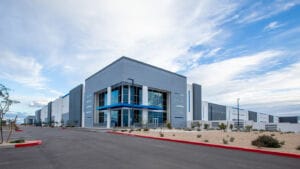CityScape, a $900 million multi-use project nearing first-phase completion in the heart of Downtown Phoenix, will finally fill the so-called “hole in the doughnut.” Located on a 3-block tract centered at the zero-zero intersection of Central Avenue and Washington Street, CityScape is seen as the catalyst for long-overdue development in the city’s core. Key players in this project, the biggest private-sector undertaking ever in Downtown Phoenix, use such phrases to describe its impact as:
“It’s going to put the heart back into Downtown Phoenix.”
“It’s going to redefine Downtown, giving the area a critical mass of retail and amenities.”
“It’s really going to help change the face of Downtown Phoenix.”
Dave Kreitor, deputy city manager for the City of Phoenix, has helped guide the Downtown area through an unprecedented period of growth, but there was always a hitch. “When I was economic development director 15 years ago, we talked about those blocks being the hole in the doughnut,” he explains. “We would never be truly effective with our Downtown redevelopment activities until that area was developed.”
Spanning Washington Street to Jefferson Street, and Second Street to First Avenue, CityScape is a 1.8 MSF project featuring a 27-story tower that will be home to myriad retail outlets, prestigious law firms and other businesses. The development’s first office tenants are expected to move in by March, with retailers showing up in April. The bulk of the tenants should be up and running by July.
Kreitor expects CityScape to create a center of activity that will relate well to nearby US Airways Center, Chase Field, the Phoenix Convention Center, Arizona State University’s Downtown campus and the core office market.
Leasing Up
As of late November 2009, leasing activity was on target. Jeff Moloznik, development manager for RED Development, says nearly 75% of the 575,000 SF of office space, and 75% of the 180,000 SF of retail space, were leased. Rates PSF were being negotiated with retailers individually, depending on the tenant, Moloznik says.
Office
Jerry Roberts, leasing broker of CB Richard Ellis, says CityScape office space is going for low-to-mid $30 PSF, depending on the length of the lease. “The pre-leasing went better than almost any building I’ve ever been involved with.”
The pace of leasing CityScape office space would be considered very successful in any real estate market, let alone the market of the last two years, Roberts adds.
One of the tenants, Squire Sanders and Dempsey, a law firm with about 110 employees, is moving across the street from the Renaissance II Building. Robert Matia, a partner at Squire Sanders, says the floor layout at CityScape is ideal for the reduced amount of space needed for secretaries.
“Lawyers coming out of law schools have spent so much time on the computer that they prefer to type their own first draft on many documents,” Matia says. The law firm will occupy 72,000 SF on 3.5 floors, with room to expand.
Represented by CB Richard Ellis, the brokerage process for Squire Sanders went smoothly. “We knew RED Development was a great group to work with,” Matia says. “They were anxious to have us there and were accommodating to our needs.”
Retail
Don Keuth, president of Phoenix Community Alliance, says CityScape creates synergy for the area. “It sends a tremendous statement about Downtown Phoenix, that it is a vital place where investments can be successful.”
He applauds RED Development, which is also the brokerage firm for the retail portion of CityScape, for making the project a reality.
Among the challenges was providing enough easy-access parking, especially for retail customers. “We accomplished this by creating an open and inviting below-grade parking environment that allows visitors to intuitively find their way from their below-grade parking stall to their retail destination,” Moloznik says.
Retailers include CVS Pharmacy, Urban Outfitters, Lucky Strike upscale bowling, Sam Fox Restaurants, Designer District, The Breakfast Club and Gold’s Gym.
The key to maintaining and enhancing a successful Downtown, Keuth says, is to get more people to live in the immediate area. “We need to create a reasonably affordable housing option so young professionals can live here and enjoy the area,” he explains.



